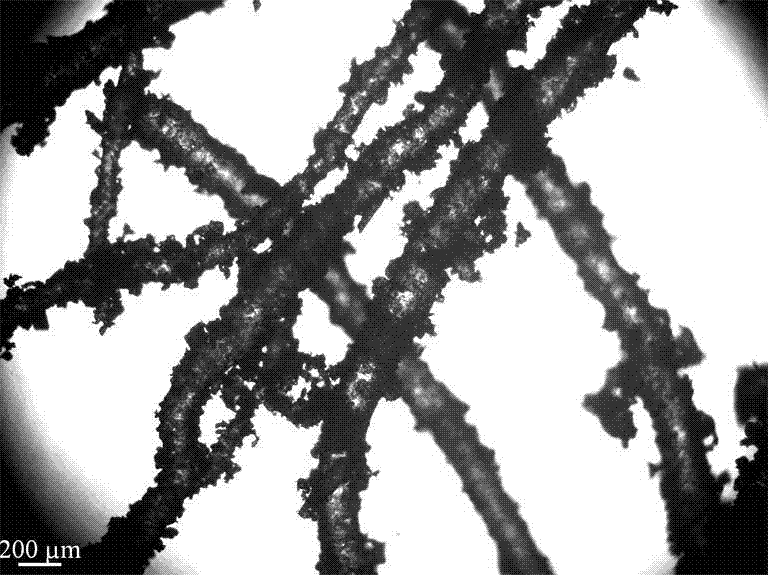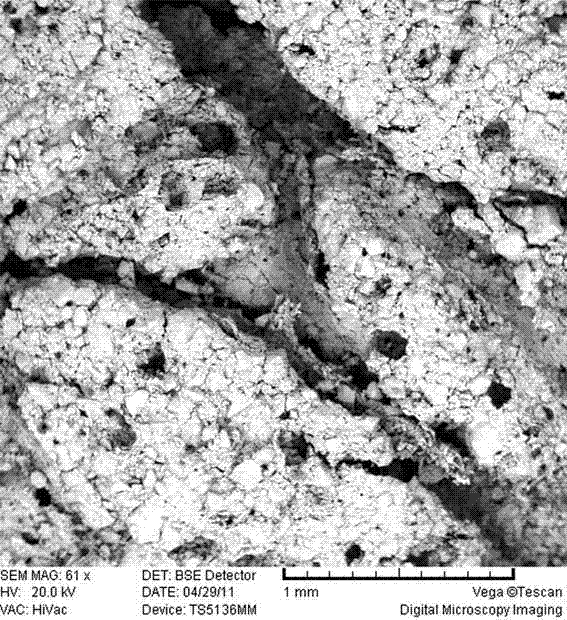A porous scaffold with network channels and its preparation method
A technology of network channels and porous scaffolds, applied in the field of biomaterials and regenerative medicine, can solve the problem of no difference in function
- Summary
- Abstract
- Description
- Claims
- Application Information
AI Technical Summary
Problems solved by technology
Method used
Image
Examples
Embodiment 1
[0035] Example 1 Add 1.8g of β-TCP to 1.1g of 5% polyvinyl alcohol (PVA) aqueous solution, stir and grind, then add 0.45g of 380-550μm diameter paraffin balls and stir evenly, then pour into a mold with 0.054g of loofah (300μm in diameter) Molding, taking out the scaffold, standing at room temperature for 24 hours, putting it into a muffle furnace and heating to 1050°C for sintering, a porous scaffold with network channels is obtained. A three-dimensional porous scaffold with channels (300 μm in diameter) with a pore size of about 450 μm and a porosity of about 50% was obtained.
Embodiment 2
[0036] Example 2 Add 1.8g of hydroxyapatite to 1.1g of 5% PVA aqueous solution, stir, grind, then add 0.45g of 380-550μm diameter paraffin balls and stir evenly, then pour into a mold with 0.054g of loofah (300μm in diameter) and mold it, take it out The scaffold was placed at room temperature for 48 hours, put into a muffle furnace and heated to 1100°C for sintering, and a three-dimensional porous scaffold with a channel (diameter of 300 μm) with a pore diameter of about 450 μm and a porosity of about 50% was obtained.
Embodiment 3
[0037] Example 3 Add 1.8g of β-TCP to 0.54g of 10% PVA aqueous solution, stir, grind, then add 0.45g of 270-380μm diameter paraffin balls and stir evenly, then pour into a mold with 0.054g of loofah (300μm in diameter) and mold it, take out the bracket, Place it at room temperature for 24 hours, put it into a muffle furnace and heat it to 1050°C for sintering to obtain a three-dimensional porous scaffold with a channel (diameter of 300 μm) with a pore diameter of about 300 μm and a porosity of about 50%.
PUM
| Property | Measurement | Unit |
|---|---|---|
| diameter | aaaaa | aaaaa |
| diameter | aaaaa | aaaaa |
| size | aaaaa | aaaaa |
Abstract
Description
Claims
Application Information
 Login to View More
Login to View More - R&D
- Intellectual Property
- Life Sciences
- Materials
- Tech Scout
- Unparalleled Data Quality
- Higher Quality Content
- 60% Fewer Hallucinations
Browse by: Latest US Patents, China's latest patents, Technical Efficacy Thesaurus, Application Domain, Technology Topic, Popular Technical Reports.
© 2025 PatSnap. All rights reserved.Legal|Privacy policy|Modern Slavery Act Transparency Statement|Sitemap|About US| Contact US: help@patsnap.com


